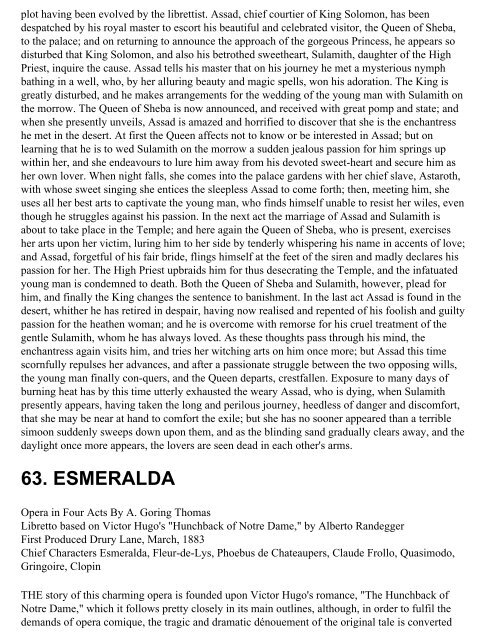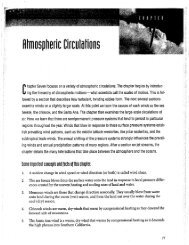Opera Plots I - MDC Faculty Home Pages
Opera Plots I - MDC Faculty Home Pages
Opera Plots I - MDC Faculty Home Pages
You also want an ePaper? Increase the reach of your titles
YUMPU automatically turns print PDFs into web optimized ePapers that Google loves.
plot having been evolved by the librettist. Assad, chief courtier of King Solomon, has been<br />
despatched by his royal master to escort his beautiful and celebrated visitor, the Queen of Sheba,<br />
to the palace; and on returning to announce the approach of the gorgeous Princess, he appears so<br />
disturbed that King Solomon, and also his betrothed sweetheart, Sulamith, daughter of the High<br />
Priest, inquire the cause. Assad tells his master that on his journey he met a mysterious nymph<br />
bathing in a well, who, by her alluring beauty and magic spells, won his adoration. The King is<br />
greatly disturbed, and he makes arrangements for the wedding of the young man with Sulamith on<br />
the morrow. The Queen of Sheba is now announced, and received with great pomp and state; and<br />
when she presently unveils, Assad is amazed and horrified to discover that she is the enchantress<br />
he met in the desert. At first the Queen affects not to know or be interested in Assad; but on<br />
learning that he is to wed Sulamith on the morrow a sudden jealous passion for him springs up<br />
within her, and she endeavours to lure him away from his devoted sweet-heart and secure him as<br />
her own lover. When night falls, she comes into the palace gardens with her chief slave, Astaroth,<br />
with whose sweet singing she entices the sleepless Assad to come forth; then, meeting him, she<br />
uses all her best arts to captivate the young man, who finds himself unable to resist her wiles, even<br />
though he struggles against his passion. In the next act the marriage of Assad and Sulamith is<br />
about to take place in the Temple; and here again the Queen of Sheba, who is present, exercises<br />
her arts upon her victim, luring him to her side by tenderly whispering his name in accents of love;<br />
and Assad, forgetful of his fair bride, flings himself at the feet of the siren and madly declares his<br />
passion for her. The High Priest upbraids him for thus desecrating the Temple, and the infatuated<br />
young man is condemned to death. Both the Queen of Sheba and Sulamith, however, plead for<br />
him, and finally the King changes the sentence to banishment. In the last act Assad is found in the<br />
desert, whither he has retired in despair, having now realised and repented of his foolish and guilty<br />
passion for the heathen woman; and he is overcome with remorse for his cruel treatment of the<br />
gentle Sulamith, whom he has always loved. As these thoughts pass through his mind, the<br />
enchantress again visits him, and tries her witching arts on him once more; but Assad this time<br />
scornfully repulses her advances, and after a passionate struggle between the two opposing wills,<br />
the young man finally con-quers, and the Queen departs, crestfallen. Exposure to many days of<br />
burning heat has by this time utterly exhausted the weary Assad, who is dying, when Sulamith<br />
presently appears, having taken the long and perilous journey, heedless of danger and discomfort,<br />
that she may be near at hand to comfort the exile; but she has no sooner appeared than a terrible<br />
simoon suddenly sweeps down upon them, and as the blinding sand gradually clears away, and the<br />
daylight once more appears, the lovers are seen dead in each other's arms.<br />
63. ESMERALDA<br />
<strong>Opera</strong> in Four Acts By A. Goring Thomas<br />
Libretto based on Victor Hugo's "Hunchback of Notre Dame," by Alberto Randegger<br />
First Produced Drury Lane, March, 1883<br />
Chief Characters Esmeralda, Fleur-de-Lys, Phoebus de Chateaupers, Claude Frollo, Quasimodo,<br />
Gringoire, Clopin<br />
THE story of this charming opera is founded upon Victor Hugo's romance, "The Hunchback of<br />
Notre Dame," which it follows pretty closely in its main outlines, although, in order to fulfil the<br />
demands of opera comique, the tragic and dramatic dénouement of the original tale is converted













